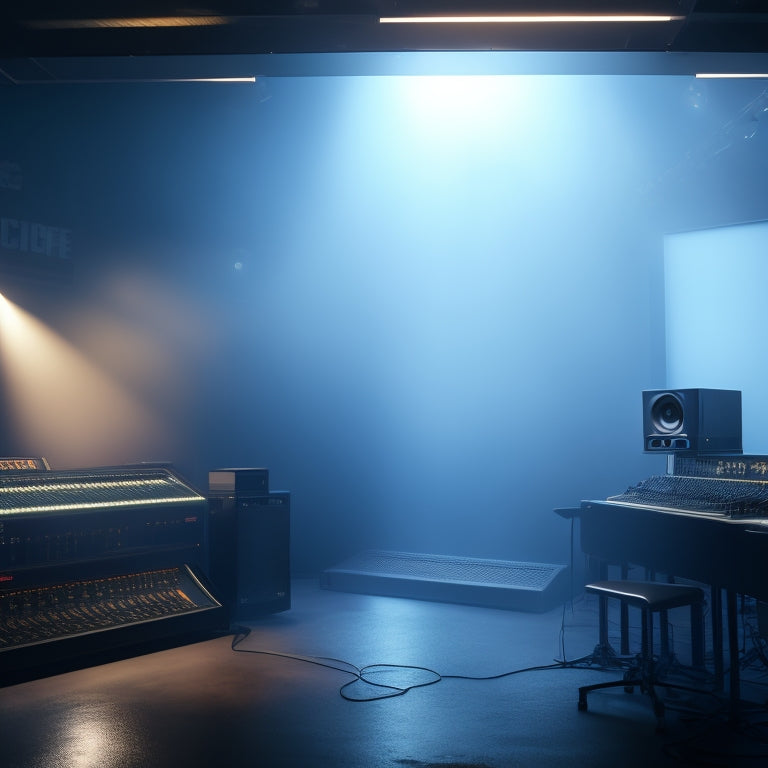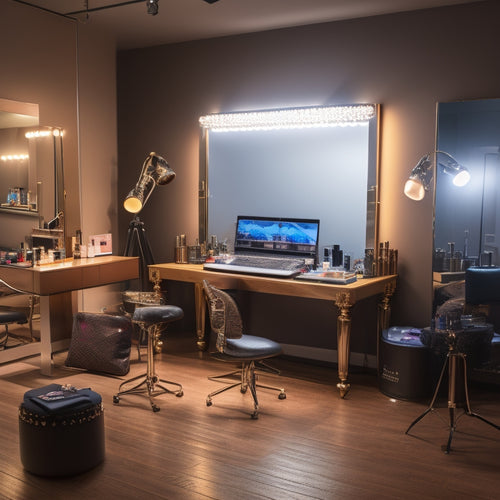
Dance Music Mastering: Achieving Sonic Brilliance
Share
As I delve into dance music mastering, I've learned that achieving sonic brilliance requires meticulous attention to detail. I start by preparing the mixdown for mastering, maintaining good gain structure and ample headroom. Next, I focus on enhancing sonic characteristics, using precise equalization, compression, and limiting to achieve tone, clarity, and dynamic range control. I also strategically manipulate stereo imaging to create an immersive listening experience. By fine-tuning these elements, I can reveal the full potential of my track. Now, I'm ready to elevate my dance music to the next level - and discover the secrets to making it truly shine.
Key Takeaways
• Ensure proper gain management to avoid clipping and distortion, setting the foundation for successful mastering.
• Utilize surgical EQ to enhance tone and clarity, and stereo widening for spatial characteristics.
• Control dynamic range with compression and limiting to create a balanced and immersive soundstage.
• Employ subtle stereo and harmonic enhancement techniques to add depth and dimensionality to the soundstage.
• Implement stereo imaging techniques, such as the Haas Effect and Mid-Side Processing, to create a more immersive and expansive listening experience.
Preparing the Mixdown for Mastering
Prior to sending my tracks to mastering, I make sure that my mixdown is properly prepared by maintaining a good gain structure throughout the mix. I start by setting all faders at -12dB on my digital mixer and aim for peaks around -6dB on the final master bus. This approach ensures that I have ample headroom for mastering, resulting in a more polished and refined sound.
Proper gain management is essential as it directly impacts the quality of the final master. By keeping my levels in check, I can avoid clipping and distortion, which could otherwise harm the overall sound quality. With a well-prepared mixdown, I set myself up for success in the mastering stage. This allows me to focus on enhancing the sonic characteristics of my track without being hindered by technical issues.
Enhancing Sonic Characteristics
With my mixdown properly prepared, I now focus on enhancing the sonic characteristics of my track through a combination of precise equalization, stereo widening, and careful use of plugins to create a balanced and immersive soundstage.
To achieve sonic brilliance, I employ the following techniques:
-
Surgical EQ: I use precise equalization to enhance the tone and clarity of individual elements, creating a balanced frequency spectrum.
-
Stereo Widening: I carefully widen the stereo image to enhance the spatial characteristics of the music, creating a more engrossing listening experience.
-
Dynamic Range Control: I use compression and limiting to control the dynamic range, maintaining a consistent loudness and energy throughout the track.
- Sonic Depth Enhancement: I use subtle stereo and harmonic enhancement techniques to add depth and dimensionality to the soundstage, creating a more engaging and spellbinding listening experience.
Stereo Imaging and Widening
By strategically manipulating the stereo image, I can create a more immersive and engaging listening experience, effectively transporting the listener into the heart of the music. To achieve this, I employ creative techniques to widen the stereo width, making the track feel more expansive and engaging. However, it's essential to prevent phase issues that can occur when using stereo widening plugins.
| Technique | Description | Prevention Strategy |
|---|---|---|
| Haas Effect | Delaying one side of the stereo signal | Adjust delay time to avoid phase issues |
| Mid-Side Processing | Isolating the center and sides of the mix | Use gentle processing to avoid phase issues |
| Stereo Imaging Plugins | Enhancing the stereo field | Use subtle settings and monitor in mono |
Frequently Asked Questions
How Many Versions of the Master Should I Create for Different Platforms?
Did you know that a staggering 85% of music listeners consume music on multiple platforms? For me, creating 3-5 master versions for different platforms is ideal, considering format options like MP3, WAV, and DDP, and platform variations like Spotify, Apple Music, and YouTube Music.
Can I Master My Track in Mono for a More Focused Sound?
"I consider mastering in mono to create a more focused sound, but I'm cautious not to sacrifice stereo width; instead, I harness mono magic to enhance clarity, while maintaining a balanced and immersive stereo field."
What's the Ideal Sample Rate for Mastering Dance Music Tracks?
'I'm obsessed with precision, so I always opt for a sample rate of 96kHz or higher for mastering dance tracks, ensuring excellent conversion quality and preserving every nuance of my sonic masterpiece.'
How Do I Prevent My Master From Sounding Too Loud or Fatiguing?
To prevent my master from sounding too loud or fatiguing, I guarantee a balanced dynamic range by maintaining a frequency balance, avoiding excessive compression, and preserving subtle nuances, resulting in a more engaging and immersive listening experience.
Should I Use Multiband Compression for Mastering Dance Tracks?
"When mastering dance tracks, I consider multiband compression to maintain frequency balance and dynamic range, ensuring a balanced sound that's neither too loud nor fatiguing, allowing the track to breathe and engage listeners."
Related Posts
-

Elevate Your Dance Makeup Business Online
You're one step away from taking your dance makeup business global. A professional online presence is key, with 75% o...
-

Explore Vibrant World of Online Dance Learning
The world of online dance learning offers an unparalleled domain of possibilities, where dancers of all levels can ac...
-

Dynamic Dance Designs: Unleash Your Creativity
By tapping into the limitless potential of Dynamic Dance Designs' cutting files, you can break free from creative con...


